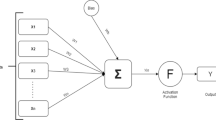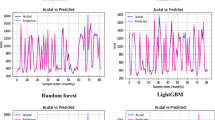Abstract
System marginal price (SMP) forecasting is essential for power generation companies or virtual transaction operators participating in the electricity market. In forecasting SMP, the load data is one of the most important pieces of information. Therefore, this paper presents a 2-Step method for SMP forecasting after load forecasting. This paper performed feature selection using Shapley additional explanations and Pearson correlation coefficient and adjusted the hyperparameters of the forecasting model by Grid search. Through this, the total load and SMP in 2021 were forecasted, and the forecasting results were presented through MAPE (mean absolute percentage error), nMAE (normalized mean absolute error), and nRMSE (normalized root mean square error). This paper used XGBoost for load forecasting and XGBoost, random forest, light gradient boosting machine, and linear regression for SMP forecasting. As a result of forecasting SMP, in the average of 2021, LGBM and RF ensemble models showed the best performance with 3.33% in MAPE. In addition, when the forecasting results were shown by dividing it into 4 seasons, the ensemble model of LGBM and random forest showed the best performance in MAPE except for spring.













Similar content being viewed by others
References
Ministry of Trade Industry and Energy (2023) The 10th Basic Plan of Long-Term Electricity Supply and Demand
Jufri FH, Oh SM, Jung JS (2019) Day-ahead system marginal price forecasting using artificial neural network and similar-days information. J Electr Eng Technol 14:561–568
Lee JK, Park JB, Shin JR, Lee KY (2005) A system marginal price forecasting based on an artificial neural network adapted with rough set theory. IEEE Power Eng Soc General Meet 1:528–533
Oh BR, Lee D-H, Lee DH (2022) Oil-price based long-term hourly system marginal electricity price scenario generation. IEEE Access 10:25051–25061
Oh HR, Son AL, Lee ZK (2021) Occupational accident prediction modeling and analysis using SHAP. J Digital Contents Soc 22(7):1115–1123
Winter E (2002) Handbook of game theory with economic applications. vol 3, pp 2025–2054
Lundberg SM, Lee SI (2017) A unified approach to interpreting model predictions. Proc Adv Neural Inf Process Syst 30:4765–4774
Son HS, Kim SY, Jang Y (2020) LSTM-based 24-h solar power forecasting model using weather forecast data. KIISE Trans Comput Pract 26(10):435–441
Aylin A (2010) Multicollinearity. Wiley Interdiscipl Rev Comput Statist 30:370–374
Maulud DH, Abdulazeez AM (2020) A review on linear regression comprehensive in machine learning. J Appl Sci Technol Trends 1(4):140–147
Najat N, Abdulazeez AM (2017) Gene clustering with partition around mediods algorithm based on weighted and normalized mahalanobis distance. Int Conf Intell Inform Biomed Sci (ICIIBMS) 2017:140–145
Kim RM, Kim KM, Ahn JH (2021) Comparison between random forest and recurrent neural network for photovoltaic power forecasting. J Korean Soc Environ Eng 43(5):347–355
Aldrich C (2020) Process variable importance analysis by use of random forests in a Shapley regression framework. Minerals 10(5):420
Park SJ, Choi WS, Lee DH (2022) Enhancing accuracy of solar power forecasting by input data preprocessing and competitive model selection methods. Trans Korean Inst Electr Eng 71(9):1201–1210
Ogunleye A, Wang Q-G (2019) XGBoost model for chronic kidney disease diagnosis. IEEE/ACM Trans Comput Biol Bioinf 17(6):2131–2140
Lee YR, Kim HJ, Lee DH, Lee CJ, Lee DH (2019) Validation of forecasting performance of two-stage probabilistic solar irradiation and solar power forecasting algorithm using XGBoost. Trans Korean Inst Electr Eng 68(12):1704–1710
Guo R, Zhao Z, Wang T, Liu GH, Zhao J (2020) Degradation state recognition of piston pump based on ICEEMDAN and XGBoost. Appl Sci 10(18):6593
Aziz RM, Baulch MF, Patel S, Ganie AH (2022) LGBM: a machine learning approach for Ethereum fraud detection. Int J Inf Technol 14:3321–3331
Alzamzami F, Hoda M, Saddik AE (2020) Light Gradient boosting machine for general sentiment classification on short texts: a comparative evaluation. IEEE Access 8:101840–101858
Shim SW, Lee DH, Roh JH, Park JB (2022) A machine learning based algorithm for short-term weekends load forecasting. Trans Korean Inst Electr Eng 71(11):1578–1584
Kim DH, Jo HJ, Kim MS, Roh JH, Park JB (2019) Short-term load forecasting based on deep learning model. Trans Korean Inst Electr Eng 68(9):1094–1099
Acknowledgements
This work was supported by the Human Resources Program in Energy Technology of the Korea Institute of Energy Technology Evaluation and Planning (KETEP) and the Ministry of Trade, Industry and Energy (MOTIE) of the Republic of Korea (No.20204010600220). This work was supported in part by the Korea Institute of Energy Technology Evaluation and Planning (KETEP) and the Ministry of Trade, Industry, and Energy (MOTIE), Republic of Korea (No.20194310100060).
Author information
Authors and Affiliations
Corresponding author
Additional information
Publisher's Note
Springer Nature remains neutral with regard to jurisdictional claims in published maps and institutional affiliations.
Rights and permissions
Springer Nature or its licensor (e.g. a society or other partner) holds exclusive rights to this article under a publishing agreement with the author(s) or other rightsholder(s); author self-archiving of the accepted manuscript version of this article is solely governed by the terms of such publishing agreement and applicable law.
About this article
Cite this article
Shim, S.W., Lee, D.H., Roh, J.H. et al. A Machine Learning-Based Algorithm for Short-Term SMP Forecasting Using 2-Step Method. J. Electr. Eng. Technol. 18, 1493–1501 (2023). https://doi.org/10.1007/s42835-023-01473-4
Received:
Revised:
Accepted:
Published:
Issue Date:
DOI: https://doi.org/10.1007/s42835-023-01473-4




